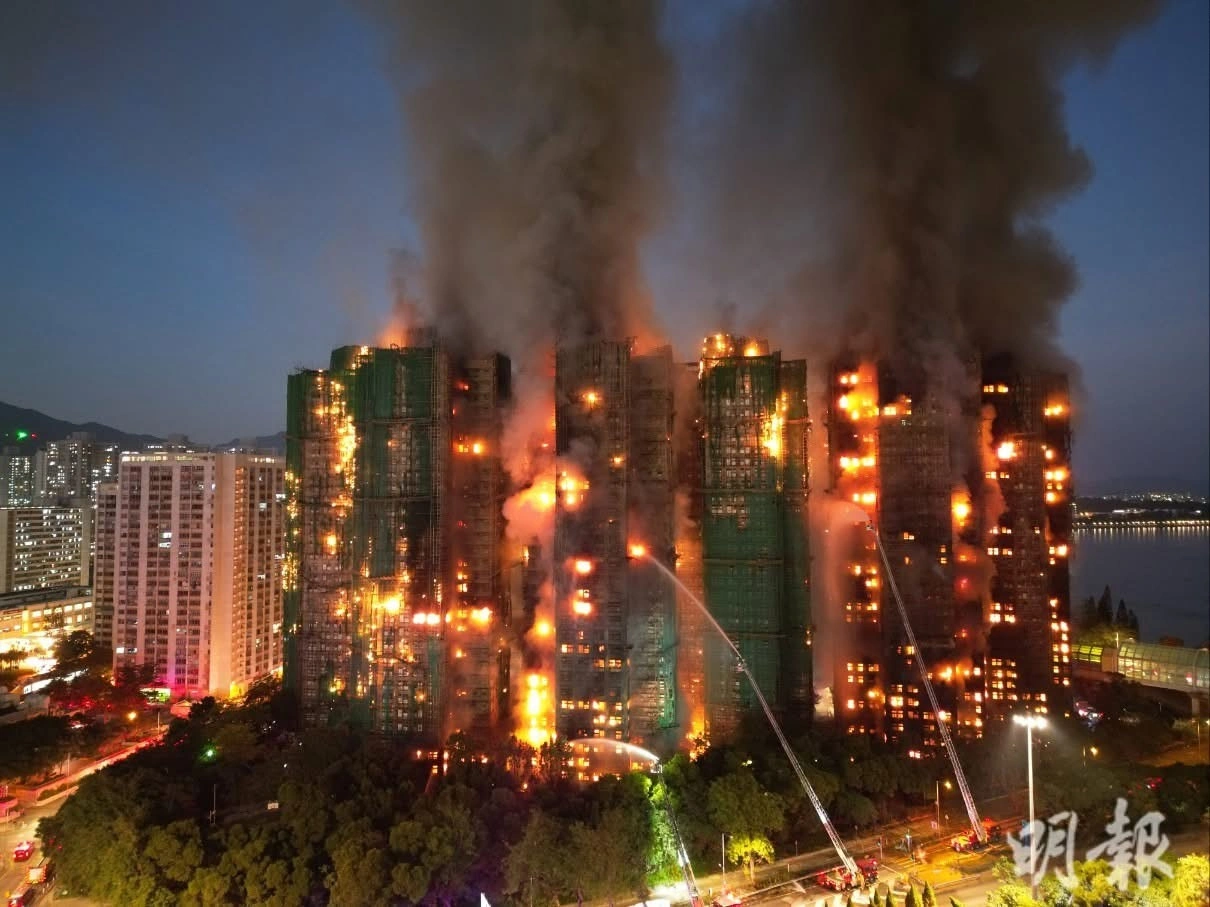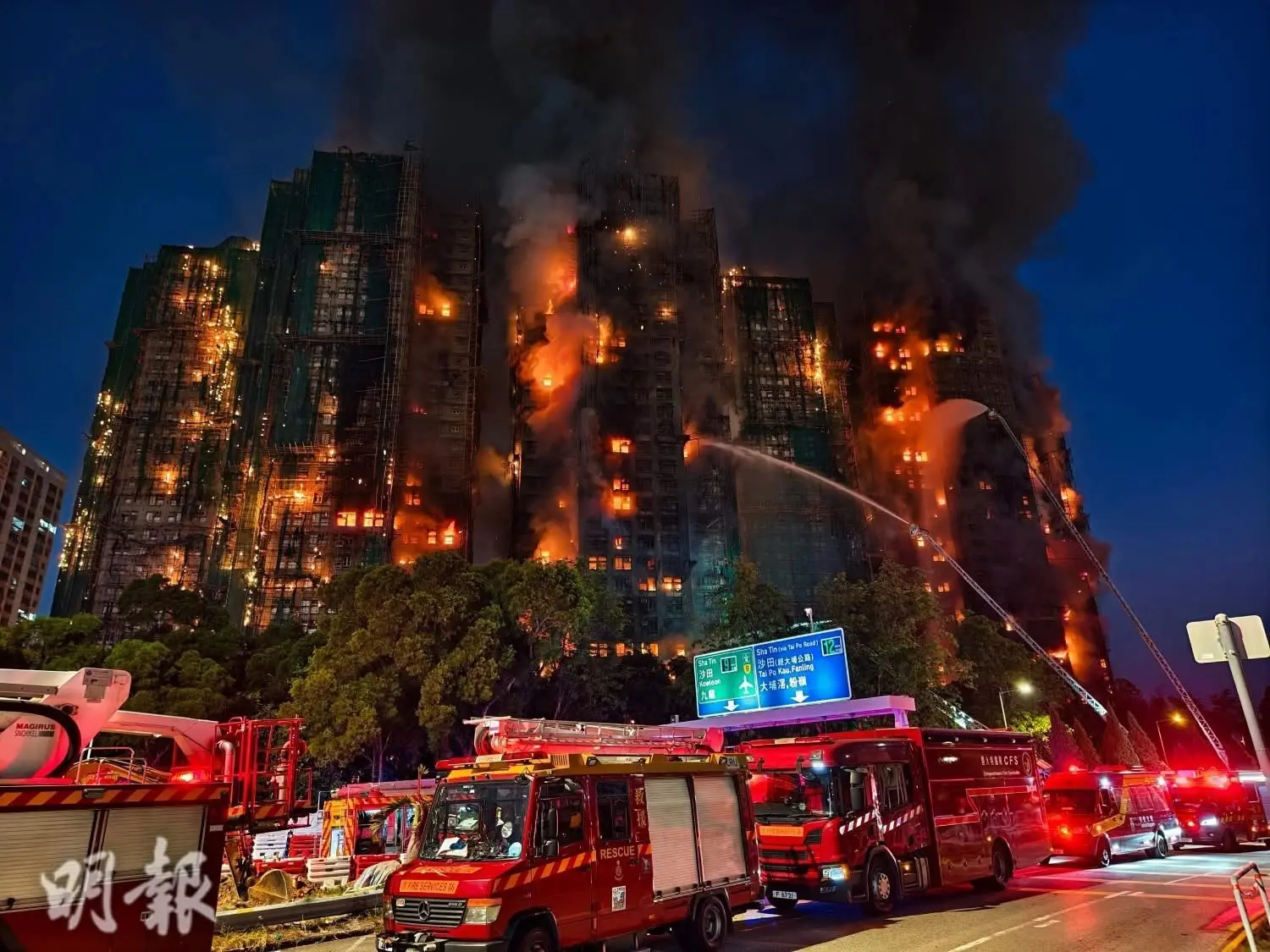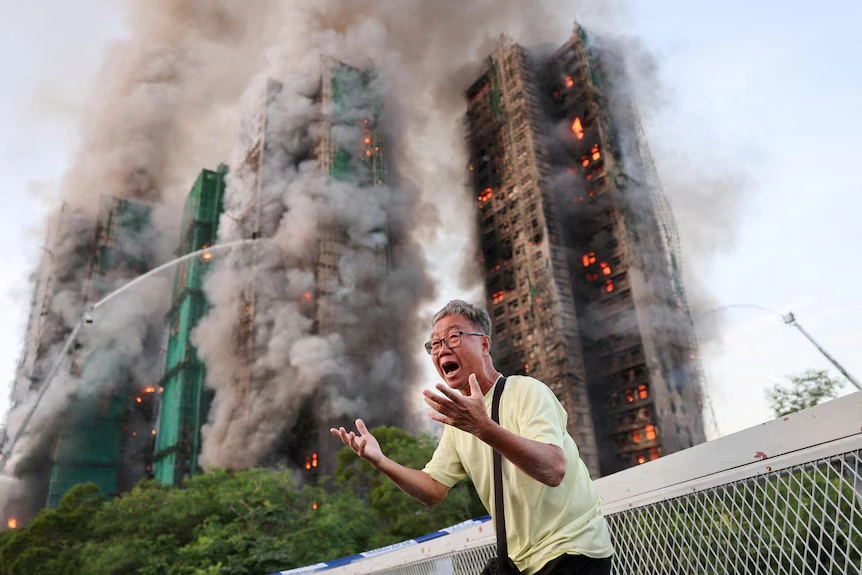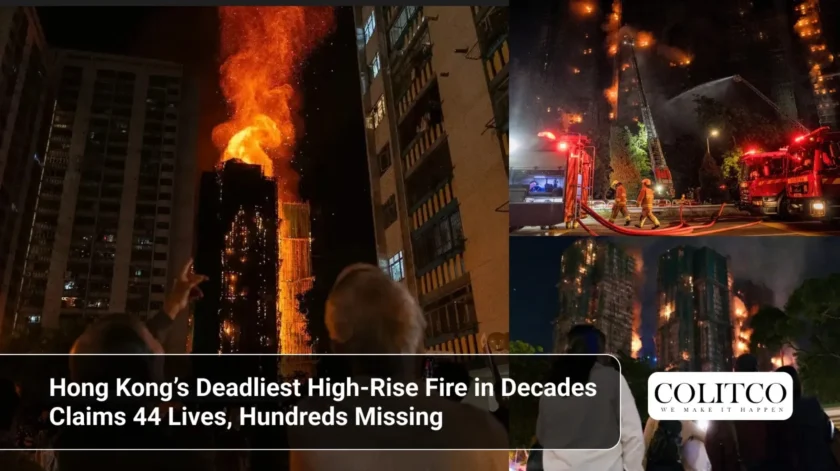Hong Kong records its worst fire in decades as a blaze engulfs a high-rise housing complex in the northern Tai Po district, leaving dozens dead, hundreds missing and thousands displaced from one of the city’s largest public estates.
Death Toll and Missing Residents
Authorities confirm at least 44 deaths after the fire sweeps through multiple towers at Wang Fuk Court, a high-rise complex of about 2,000 flats sheltering roughly 4,800 residents. Officials state that about 279 people remain unaccounted for as emergency crews continue searches in burned apartments and smoke-filled stairwells.

Fire engulfs high-rise apartment buildings in Hong Kong
Health authorities report at least 15 injured residents, including people with severe burns and smoke inhalation. Officials confirm that one firefighter died during the response and others received treatment for heat-related conditions.
Location and Scale Of The Blaze
The fire starts on Wednesday afternoon in the Tai Po district in Hong Kong’s New Territories, about a 20-minute drive from the city’s main tourist areas. Flames spread quickly across scaffolding wrapped around the 31-storey towers, before jumping between blocks inside the tightly packed complex.

The blaze engulfs at least seven high-rise residential buildings within Wang Fuk Court and triggers a prolonged firefighting effort through the night. Authorities classify the incident as a level 5 alarm, the city’s highest category, marking Hong Kong’s most serious fire since a 1996 commercial building disaster that killed 41 people.
Firefighting Operation and Resources
The Fire Services Department deploys about 700 firefighters, paramedics and police officers as the incident escalates. Officials confirm that 128 fire engines and 57 ambulances respond to the scene as black and grey smoke rises above the New Territories skyline.

High temperatures inside the buildings made it dangerous for firefighters to enter
Responders reach the complex within minutes after an emergency call around 2:50 p.m. local time and raise the alarm level to its maximum shortly after 6:20 p.m. as flames expand across multiple facades. Crews work through the night under intense heat, using ladder trucks and interior teams to attack fires burning on several floors at once.
Conditions Inside The Burning Towers
Officials describe interior conditions as extremely hot and hazardous as teams attempt rescues in dark corridors filled with heavy smoke. Falling debris and collapsing scaffolding create additional risks for firefighters trying to reach residents calling for help from upper floors and enclosed balconies.
“Debris and scaffolding from the affected buildings are collapsing,” says Derek Armstrong Chan, deputy director of Fire Services (Operations). “The temperatures inside the buildings are extremely high, making it challenging for us to enter and conduct firefighting and rescue operations,” Chan says.

Fires continued to burn on Wednesday evening in Hong Kong
Bamboo Scaffolding and Maintenance Works
Investigators focus on bamboo scaffolding and foam insulation materials used in ongoing renovation works around the towers, which form a combustible vertical channel along building exteriors. Police state that the blaze likely spreads through these materials and then penetrates apartments, contributing to rapid fire growth and extensive smoke.

The fire raises questions about safety controls
The government has previously announced plans to phase out bamboo scaffolding on public projects due to safety concerns, although it remains common on private and older sites. The fire raises questions about safety controls on refurbishment work in dense high-rise estates dominated by ageing concrete towers and narrow escape routes.
Evacuations and Displaced Residents
Officials evacuate nearby blocks as flames spread across the complex and smoke drifts over adjacent neighbourhoods. District authorities establish temporary shelters in community centres and schools, accommodating about 700 residents who cannot return home because of fire damage, smoke contamination or safety cordons.
Authorities set up a casualty hotline to help families locate missing relatives and confirm hospital admissions. Local councillors report that many residents in the estate are elderly people and lower-income households relying on subsidised public housing, intensifying concerns about relocation and support.

A man appeals for help as the blaze engulfs Wang Fuk Court
Transport and Citywide Disruption
Transport officials close sections of Tai Po Road, a major highway, and divert more than 30 bus routes as emergency vehicles crowd access points around the estate. Commuters face delays across northern corridors as authorities maintain perimeter controls to allow continuous firefighting operations and structural inspections.
The fire produces visible smoke plumes across large parts of the New Territories, and residents in surrounding districts receive advice to keep windows closed and stay indoors while air quality monitors track pollution levels. Utility and maintenance crews work to secure gas, water and electricity systems in affected towers and neighbouring blocks.
Official Responses and Statements
Hong Kong Chief Executive John Lee convenes an emergency meeting and directs agencies to provide full support for rescue, medical care and rehousing. Lee orders a formal investigation into construction practices, fire safety compliance and renovation oversight at Wang Fuk Court and similar estates.
Hong Kong SAR Chief Executive John Lee said in the small hours on Thursday that a fire at Wang Fuk Court, a residential area in Tai Po of Hong Kong, has been gradually brought under control after firefighters’ tireless efforts https://t.co/Eivqpgai9E pic.twitter.com/0GtMU2PCxu
— China Xinhua News (@XHNews) November 27, 2025
Chinese President Xi Jinping expresses condolences to the victims’ families and urges authorities to minimise casualties and stabilise public order. City officials promise interim financial assistance for affected households, including payments for funeral expenses, temporary accommodation and essential goods.
Also Read: Christmas Cheer Turns Sour for Mortgage Holders as Inflation Sparks Rate‑Hike Fears
Police Investigation and Arrests
Police confirm that they are treating the fire as a major incident and have opened a criminal investigation into possible negligence linked to renovation work, scaffolding installation and material choices. Investigators examine whether foam cladding or other combustible products breach building regulations or safety guidelines for occupied residential towers.
Authorities later arrested three construction-related officials on suspicion of endangering public safety through unsafe practices at the site. Detectives gather project documents, inspection records and contractor logs while forensic teams review fire patterns across the seven affected towers.
Historical Context and Safety Concerns
Officials and analysts describe the Tai Po blaze as Hong Kong’s worst fire in nearly three decades and its deadliest residential incident in modern times. The scale of the casualties and the number of missing people draw comparisons with a 1996 commercial building fire that killed 41 people in Kowloon.
Fire safety experts note that the incident highlights systemic vulnerabilities in older high-rise estates, including reliance on external scaffolding, complex evacuation routes and ageing fire protection systems. Calls grow for comprehensive inspections of scaffolding projects, cladding materials and emergency access arrangements across the city’s dense public housing portfolio.












